Richebourg is a legendary vineyard – and while Romanee-Conti, La Romanee and La Tache are regarded as slightly better, most Burgundy lovers can tell you about a very special moment with a bottle of Richebourg.
My Richebourg moment was Henri Jayer Richebourg 1985 – tasted back in 2002 – a legendary wine and a typical Richebourg … big, powerful and still very young at the age of 17.
The quality of Richebourg has improved quite a lot during the last 20 years, but even before this the overall quality of the wines from Richebourg were very high compared to other Grand Crus with multible owners.
But let us take a closer look at Richebourg … the history, the plots and the owners.
History of Richebourg
It’s somewhat unclear when the name Richebourg was first used, but documents show that the term Richebourg was used as early as 1512 according to Jean-François Bazin.
Richebourg today includes two climats – Les Richebourg 5.05 ha (the original part) and Les Verroilles ou Richebourg 2.98 ha – in total 8.03 ha. – see maps below.
Early history of Les Richebourg
Les Richebourg was like most of the known vineyards in Burgundy owned mostly by the Church up til the French revolution in 1790. In the case of Richebourg a large part of the current vineyard was under the ownership of monestary of Citeaux.
In 1791 the vineyards of the Abbey of Citeaux were sold to a Parisian banker Jean Focard1. The path of ownership is however somewhat unclear, but it seems likely that Richebourg was traded several times after the initial deal with Focard – that was at least the case with Clos de Vougeot, which was sold at the same time to Focard.
Early history of Les Verroilles sous Richebourg
Les Verroilles was mentioned as Clos des Varoilles in 1774 by Abbe Claude Courtépée11. Courtépée mention that 4 journaux (1,4 hectare) of Clos des Varoilles were owned by M. Jaquinot de Chazan – thus indicating that at least a part of Verroilles separated from the church ownership before the revolution. Clos des Varoilles was also mentioned by Maupin 10 in 1784, where he mention Clos des Varoilles and the owner M. de Chasan – see picture below.
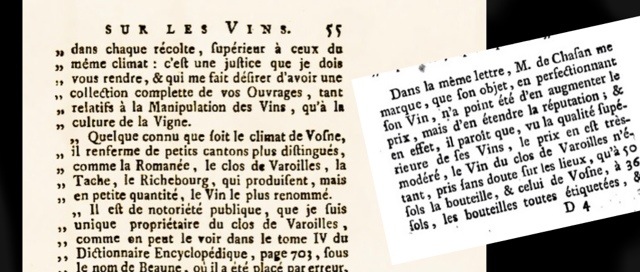
Full page from Maupin’s book click here
The 1,4 hectare of Clos des Varoilles mentioned by Courtépée does not cover the total area of Les Verroilles sous Richebourg – but the area is approximately the same as the Gros holdings in Les Verroilles.
In 1827 the cadastral system was established and this could have changed some of the borders between the different climates – but it’s interesting that the vineyard was mentioned as a “Clos” as the both the AF Gros and Gros Frere et Soeur holdings have a wall on the northern side towards Chambolle Musigny and there is another wall between the Meo-Camuzet Plot and the Gros plots.
Anyhow the name Clos des Varoilles was not used further on, and Lavalle mention the climate as Les Varoilles sous Richebourg, while the term officially used today is Les Verroilles ou Richebourg. The change from “sous” to “ou” was a part of the unification proces, as the owners on Les Verroilles wanted to link the vineyard closer to the Richebourg brand.
The unification of Les Richebourg and Les Verroilles sous Richebourg
Les Richebourg and Les Verroilles sous Richebourg were separate vineyards until they were unified under the name of Richebourg in 1924. Even today the two climates in Richebourg are still mentioned on some maps, and in the official records the two climates are still maintained separate.
Before the unification of Richebourg in 1924 there were a lot of discussions and even legal battle about the right to bottle the wines from Les Verroilles sous Richebourg under the name Richebourg.
Some considered Les Richebourg to be the superior vineyard, while the owners on Les Verroilles sous Richebourg argued differently. Lavalle (1855) classified Les Richebourg as Tete de Cuvee while he rated Les Veroilles sous Richebourg as Premiere Cuvee. Rodier (1920) disagreed and rated both climates Tete de Cuvee.
Les Richebourg is facing directly east with the rows of vines going east/west and this climate has a somewhat better exposure to the sun, while Les Verroilles is facing more northeast with the rows going north/south. In general the harvest is earlier on Les Richebourg due to the more direct exposure to the sun. Henri Jayer mention that one normally should harvest Les Verroilles 2 – 3 days after Les Richebourg, and that the grapes from Verroilles “promise lover alcoholic content but always a better pH12
In the “old days” … before global warming … the better exposure of Les Richebourg could be an advantage in lesser years, but in the last two decades most vintages have produced grapes with good ripeness – and the northeast exposure of Verroilles can even be an advantage in hot years.
Summing up I don’t think there is a big difference in quality today – and the wines from the Verroilles terroir in general are matching the quality of the wines produced on Les Richebourg. Stylewise the wines from Les Richebourg can be slightly more dense and massively powerful, while some wines form Les Verroilles enjoy slightly better acidity and sometimes a more pronounced stony minerality. But to be honest the difference between the produceres is far bigger than the difference in terroir between the two climates – and many wines are indeed a mix of the two climates.
In the end Les Verroilles sous Richebourg was added to the Richebourg vineyard in 1924. In 1936 the vineyard gets AOC Grand Cru status for the full area today know as Richebourg – and the two climates as Les Richebourg and Les Verroilles ou Richebourg.
The ownership of Richebourg – the sources and reference points
The ownership of Richebourg in the decades after the revolution is not very well described, but there are three reference points and sources – Lavalle (1855), Danguy and Aubertin (1892) and Rodier (1920).
My angle on this is to take each of the current plots and take a look at the historic ownership of these plots. In most cases this will take us 100 years back .. sometimes even further.
The current ownership of Richebourg
Today Richebourg is devided between 11 owners, with Domaine de la Romanee-Conti as the main and principal owner in both Les Richebourg and Les Verroilles.
- Domaine de la Romanee Conti – 3.51 ha
- Domaine Leroy – 0.78 ha
- Gros Frere et Soeur – 0.69 ha
- A.F. Gros – 0.60 ha
- Anne Gros – 0.60 ha
- Thibault Liger-Belair – 0.55 ha
- Meo-Camuzet – 0.35 ha
- Jean Grivot – 0.32 ha
- Mongeard Mugneret – 0.31 ha
- Hudelot-Noellat – 0.28 ha
- Frantin – 0.07 ha
On the map below I have attached ownership to the different parts on Richebourg.
The historic ownership of Richebourg
Next step is to explore the history of each of the current plots, and try to establish a historic view on the ownership. The reference point for this work is Lavalle1 and he mention the following owners on Richebourg in 1855:
Les Richebourg in 1855 (4 hect. 93 ares 45 cent.):
- Duveaux (Duvault-Blochet)
- Marey
- Liger-Belair
- Lausseure
- Marillier
- MM. Frantin
Verroilles Sous Richebourg in 1855 (3 hect. 6 ares):
- M. Frantin
Historic view on the ownership of Les Richebourg
There are currently 6 domaines producing wine mainly from Les Richebourg. One owner – Domaine de la Romanee-Conti – also have holdings in Les Verroilles and the DRC Richebourg is based on both climates.
The map below show the owners in Les Richebourg.
Domaine de la Romanee Conti
Domaine de la Romanee Conti own two large sections in Les Richebourg. The southern section just north of Romanee-Conti and La Romanee. This section include several smaller plots going from the road in the bottom of Richebourg and all the way up to Les Petit Monts. The second section is located further north and this also consist of several plots. Most of the plots were acquired by Duvault-Blochet before his death in 1874. I’m still working on some more details about the DRC plots – and will update the article when I find more information.
Hudelot-Noellat
The Hudelot-Noellat plot is located in the center of Les Richebourg just above Romanee-Saint-Vivant. The plot is from the Domaine Charles Noellat holdings in Richebourg, and Hudelot-Noellat got the plot around 1976 along with his plot in Romanee Saint-Vivant.
Charles Noellat is not mentioned as a owner in Les Richebourg by any of the sources, but in 1920 Rodier mention Noellat as owner in Verroilles ou Richebourg. It’s most likely that Charles Noellat bought this Les Richebourg plot in 1925 from the Gaudemet-Chanut estate. Charles Noellat was managing the Gaudemet-Chanut estate until the death of Marguerite Gaudemet in 1925, and after her death the heirs sold the estate to Charles Noellat. Charles Noellat could also have acquired plots in Richebourg from Dr. Jules Edouard Chanut at a earlier stage – if so most likely between 1905 and 1907.
Mongeard Mugneret
This plot is located in the center of Les Richebourg just below Les Petits Monts. Mugneret acquired this plot in 1984 from Charles Vienot – Mugneret got half the original Vienot plot and Grivot the other part.
The Charles Vienot plot dates back to before 1920, where Rodier (1920) mention Vienot as one of the owners on Richebourg. Charles Vienot is not mentioned by Lavalle (1855) and Danguy and Aubertin (1892) as a owner of Richeborg. It is likely that the Vienot plot originates from the Dr. Jules Edouard Chanut estate. Danguy and Aubertin mention both Chanut and Gaudemet as owners on Richebourg in 1892.
Jean Grivot
This plot is also located in the center of Les Richebourg just below Les Petits Monts. Givot acquired this plot in 1984 from Charles Vienot – Mugneret got the other half of the Vienot plot. The Charles Vienot plot dates back to before 1920, where Rodier (1920) mention Vienot as one of the owners on Richebourg – like the Mongeard-Mugneret plots it’s most likely from the Chanut holdings.
Thibault Liger-Belair
The Liger-Belair family has owned vineyards on Richebourg since before 1855. The holdings on Les Richebourg is mentioned by Lavalle (1855) and the other sources.
Originally the vineyards were owned by Claude Marey, who was secretary of the king and mayor of Nuits-Saint-Georges. In 1720 he established the wine merchant business C. Marey. In 1781 his son Claude Philibert Marey, takes over the wine merchant house. At the death of Claude Philibert Marey in 1804 his son Guillaume Felix Marey takes over – and in 1852 his son in law – Comte Louis Liger-Belair – becomes an associate in the business that now trades in the name of C.Marey and Comte Liger-Belair13.
At the death of Guillaume Felix Marey in 1869 Comte Louis Liger-Belair continues to manage the merchant house alone until his death in 1878. After his death his son, the Comte Edgard Liger-Belair, becomes chairman of the wine merchant business. In 1915 Comte Edgard Liger-Belair passed away and were succeded by his three sons13
In 1949 Felix Liger-Belair, son of the Comte Edgard, becomes sole chairman of C.Marey and Comte Liger-Belair – with his son Xavier as general manager of wine merchand business. At the death of Xavier Liger-Belair in 1982 the wine merchant business is sold off. In the same year his son Vincent, supported by his mother, takes over and restructures the Domaine13. Three different vinegrowers take over the management of the vineyards – Richebourg was managed by Domaine Denis Mugneret (now Dominique Mugneret) on a lease until 2002.
In 2001 Thibault Liger-Belair, the son of Vincent Liger-Belair, creates Domaine Thibault Liger-Belair to run the the family’s vineyards. First vintage of Richebourg for Thibault Liger-Belair is 2002.
Domaine Leroy
Domaine Leroy own two plots in Les Richebourg, one big plot in the northern part of the vineyard on the border to Les Verroilles ou Richebourg and one smaller plot located between DRC and Mongeard-Mugneret a little further south. The Leroy plots were acquired in 1988 when they bought the Charles Noellat estate. Like the Hudelot-Noellat plot – these plots could well be acquired from the Chanut and Gaudemet holdings. Gaudemet is mentioned as owner on both Richebourg and Romanee-Saint-Vivant in 1920 by Rodier, and Charles Noellat acquired the Gaudemet-Chanut estate in 1925. I have seen a Charles Noellat Richebourg 1929 and a Romanee-Saint-Vivant 1926 most likely made on the vineyards acquired from Gaudemet-Chanut.
The boarder between Verroilles and Les Richeborg
The Richebourg vineyard includes two separate climates – Les Verroilles ou Richebourg and Les Richebourg. Some holdings are divided in two – one part in Verroilles and the other part in Les Richebourg. It’s the Gros family holdings that are divided by the boarder between the two climates – see map below.
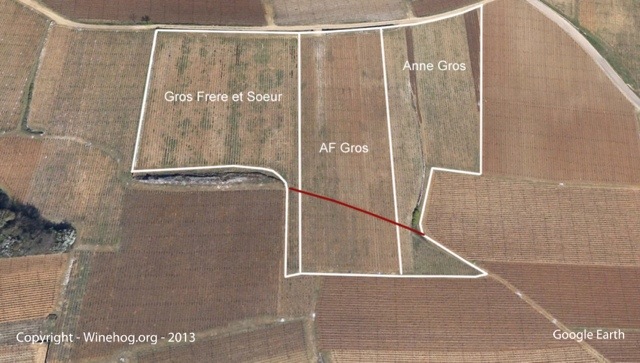
The red line is the boarder between the two climates, and it’s seen that Gros Frere et Soeur, AF Gros and Anne Gros all have plots in Les Richebourg, while the main part of the holdings are located in Les Verroilles ou Richebourg. Gros Frere et Soeur has one plot in Les Richebourg, while AF Gros has three and finally Anne Gros has two plots. It should be notet that the ownership structure of the plots within the Gros familly is rather complex as there are a joint ownership of some of the plots. So the distribution of the plots is only showing who is making the wine from the plots currently.
Historic view on the ownership of Les Verroilles sous Richebourg
As mentioned the two climates on Richebourg are still separate, and some holdings are crossing the boarder between the two climates. These plots are all mentioned under the ownership on Verroilles, as the main part of these plots are in this climate.
The map below show the owners in Les Verroilles ou Richebourg.
Frantin
The current Frantin plot is located on the very top of Verroilles ou Richebourg section. The vineyard is next to Meo-Camuzets main plot, and is with it’s 0.07 ha by far the smallest plot on Richebourg.
According to Lavalle (1855) – Frantin was the only owner on Verroilles ou Richebourg. The Frantin estate was founded by Antione Vincent Legrand mainly with vineyards bought as “bien nationaux” after the revolution. The next generation was his daughter Louise Legrand and her husband Jean-Edme Frantin – therefore the name Clos Frantin 9. Jean-Edme Frantin died in 1863, and after this some of the vineyards were sold of – but it’s somewhat unclear when this happened. The Chanut family bought the Frantin estate in Vosne-Romanee in 1863, but only the village vineyard Clos Frantin is mentioned as a part of this deal. There is no trace of Les Verroilles ou Richebourg in the estate after Philibert Eugene Chanut who died in 1885.
The current Frantin plot, now owned by Albert Bichot, should according to my sources be a part of the original Frantin holdings. This is however not supported by Danguy and Aubertin (1892) – but Rodier mention Grivelet-Modot as owner in 1920, so most likely the small Frantin plot is a part of the original holdings. Bichot took over the Frantin brand and the Grivelet estate in 1964.
Domaine Meo-Camuzet
Meo-Camuzet own two plots – the main plot in Verroilles and a very small plot in Les Richebourg just below Cros Parantoux. Accoring to Rodier – Camuzet was a owner on Verroilles in 1920 and he is also mentioned as a owner by Danguy and Aubertin in 1892. The Domaine was however founded in the beginning of the twentieth century so it appears that Camuzet owned these vineyards before the domaine itself was established. The small plot in Les Ricebourg is not mentioned by Rodier (1920) or Danguy and Aubertin (1892). It’s unclear when Etienne Camuzet acquired these plots, and from whom.
Henri Jayer leased these plots en metayage from the 1940s until 1987, where Meo-Camuzet took over the vineyards. The last vintage of Henri Jayer Richebourg is 1987. First vintage of the Meo-Camuzet Richebourg is the 1985 – made by Jayer but with a Meo-Camuzet label.
The Gros family plots
The Gros family have in total almost 2 ha of Richebourg – mostly located in Verroilles sous Richebourg. The Gros plot was acquired by Louis Gustave Gros in 1882 – and the area is still owned by the Gros family – but currently divided between three producers – Gros Frere et Soeure, A.F. Gros and Anne Gros.
It’s unclear if Louis Gustave Gros acquired the plots from Chanut, or if the Frantin holdings on Les Verroilles ou Richebourg were sold off to another domaine after the death of Jean Edme Frantin in 1863.
It should be notet that Gros is not mentioned as a one the owners on Les Richebourg by Danguy and Aubertin in 1892, but Rodier (1920) mention Gros Renaudot as owner on both Les Richebourg and Les Verroilles ou Richebourg indicating that the Les Richebourg plots of the Gros holdings were included after 1892. Frantin was however mentioned by Lavalle (1855) as a owner on Les Richebourg, so it’s possible that the Gros holdings in Les Richebourg was acquired along with the plot in Les Verroilles – these plots could well originate from the Chanut family.
You need to login to read the rest of this article. If you are not a subscriber, use the subscribe function and sign-up.

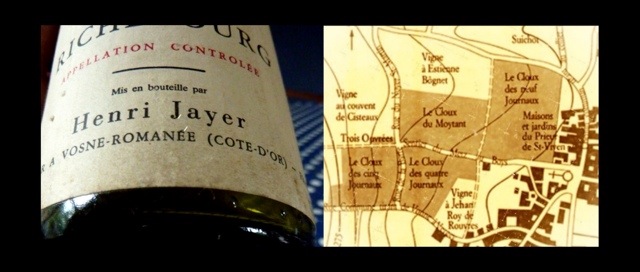
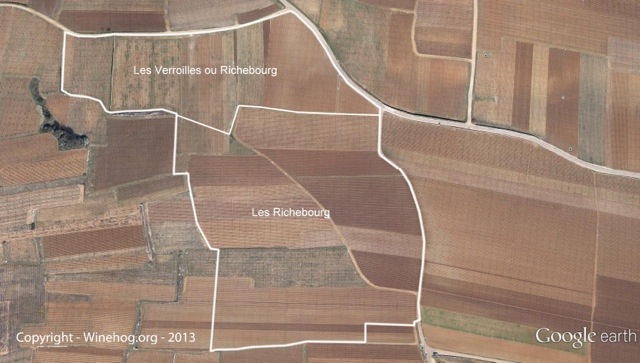
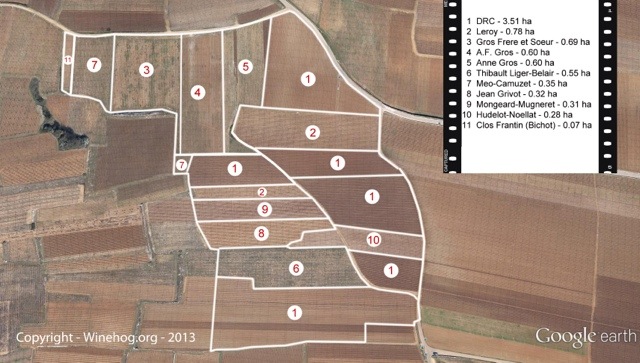
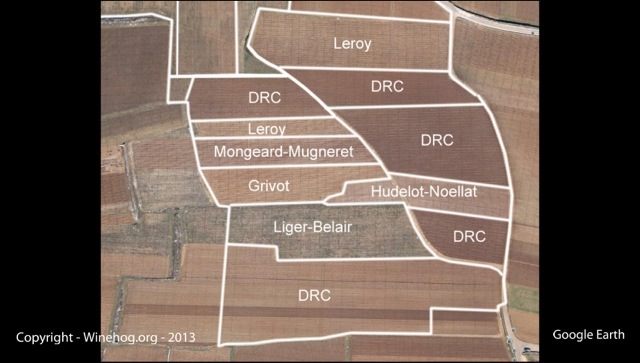
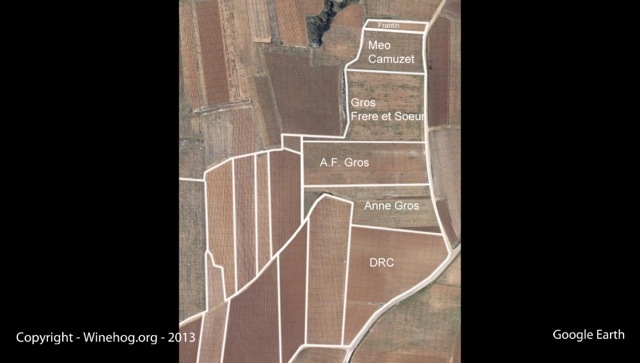
 - A true vin d’émotion – a Burgundy of passion
- A true vin d’émotion – a Burgundy of passion - A truly hedonistic wine – lively and enjoyable
- A truly hedonistic wine – lively and enjoyable - A vivacious wine for pure indulgance
- A vivacious wine for pure indulgance - A potential vin d´émotion - frais et léger
- A potential vin d´émotion - frais et léger